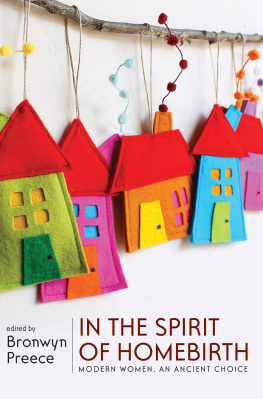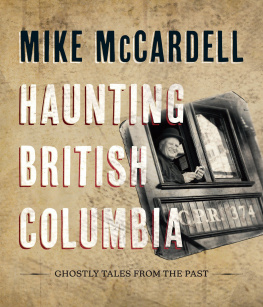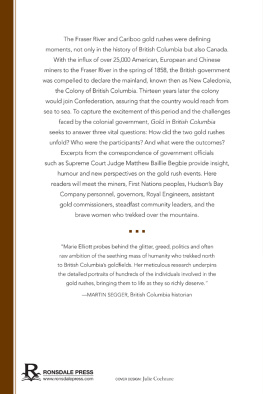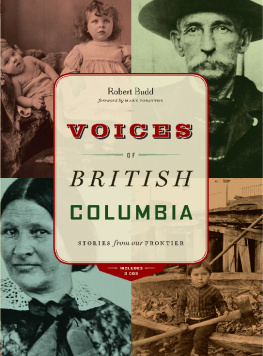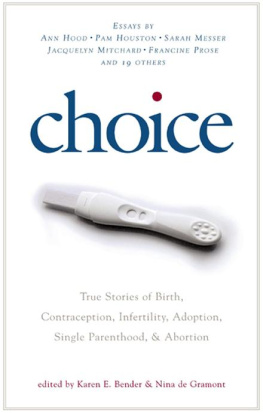Preece - In the spirit of homebirth: modern women, an ancient choice
Here you can read online Preece - In the spirit of homebirth: modern women, an ancient choice full text of the book (entire story) in english for free. Download pdf and epub, get meaning, cover and reviews about this ebook. City: British Columbia, year: 2015, publisher: Seven Stories Press, genre: Home and family. Description of the work, (preface) as well as reviews are available. Best literature library LitArk.com created for fans of good reading and offers a wide selection of genres:
Romance novel
Science fiction
Adventure
Detective
Science
History
Home and family
Prose
Art
Politics
Computer
Non-fiction
Religion
Business
Children
Humor
Choose a favorite category and find really read worthwhile books. Enjoy immersion in the world of imagination, feel the emotions of the characters or learn something new for yourself, make an fascinating discovery.
- Book:In the spirit of homebirth: modern women, an ancient choice
- Author:
- Publisher:Seven Stories Press
- Genre:
- Year:2015
- City:British Columbia
- Rating:5 / 5
- Favourites:Add to favourites
- Your mark:
- 100
- 1
- 2
- 3
- 4
- 5
In the spirit of homebirth: modern women, an ancient choice: summary, description and annotation
We offer to read an annotation, description, summary or preface (depends on what the author of the book "In the spirit of homebirth: modern women, an ancient choice" wrote himself). If you haven't found the necessary information about the book — write in the comments, we will try to find it.
Preece: author's other books
Who wrote In the spirit of homebirth: modern women, an ancient choice? Find out the surname, the name of the author of the book and a list of all author's works by series.
In the spirit of homebirth: modern women, an ancient choice — read online for free the complete book (whole text) full work
Below is the text of the book, divided by pages. System saving the place of the last page read, allows you to conveniently read the book "In the spirit of homebirth: modern women, an ancient choice" online for free, without having to search again every time where you left off. Put a bookmark, and you can go to the page where you finished reading at any time.
Font size:
Interval:
Bookmark:

The names of the midwives, doulas, doctors, and nurses
mentioned in these personal accounts have been
changed to protect their privacy.
The names of those midwives and doulas who have included
their own accounts have not been changed.
All other names are real.

Real stories by real people...
Home is the most
appropriate birth setting for
most childbearing women.
World Health Organization
On the floor of my homea cabin built to be ready for the birthI have painted a star that marks the spot where my daughter was born. Arriving at four in the morning into her fathers waiting hands, my baby was birthed with an inherent knowingthe ease of an ancient, entrenched familiarity of what-to-do. But most importantly to meI birthed a healthy baby and I was at home.
I wanted to birth with gentleness. I wanted to make my childs entry into this world as fluid as possible. I hoped for a seamless transition for her from the internal safe haven of my womb to our awaiting, welcoming environment. I wanted to create and be in control of the atmosphere and surrounding ambiance. Choosing to birth at home granted me this hope.
The desire to bond with this new little being in the comfort of the home she would be raised in was of paramount importance to my partner and me. We wanted her initial smells to be of her mother, her father, her hometo have this sanctuary immediately tangible for her. Our hope was to have her drawn to my breast, umbilical cord still pulsating, and for her eyes to open for the first time to a soft light, rather than the buzz of flickering fluorescents. We wanted to cradle our newborn, rather than have her carried away and bathed instantaneously. My role as mother, and my partners role as father, were not to begin once our baby was handed back to us: our desire was for there to be no in-between time.
We were, and are, not alone in this desire. In the Spirit of Home- birth houses a collection of birth stories. These are stories told by people, mainly women, from British Columbia (BC), Canada. Stories by and about women and families who all carried the intent to birth at home. These are stories told by people, mainly women, from British Columbia, Canadastories about women and families who all carried the intent to birth at home. These are personal accounts shared by those who carried pregnancies under the care of midwives and other nurturing figures.
This collection values diversity and accessibility. It is broadly inclusive, giving voice to those often overlooked or unheard. The pieces range in writing styles and manners of presentation and narrative. There is something distinctly powerful about making the extraordinary ordinary and the ordinary extraordinary. This collection does just that. It is an eclectic mix of stories that illustrates that homebirthing is accessible to (almost) everyonebe you urban, rural, single, or happily married; be you an Amazon or waif, an academic, a high school dropout, black, white, straight, lesbian, or somewhere in-between; be you a polished and poetic writer, or someone who struggles with words. This book prioritizes no one story, nor any one voice over another. And through the sharing of these stories, homebirthing emerges as a healthy alternative for the whole family.
The personal narratives contained in this collection correspond with a movement that is currently raising critical questions about many of the Western birthing practices often associated with hospital deliveries. Questions related to the high rate of cesarean section; the increasing frequency of interventions and the use of machinery; the use of epidurals and other pain-relieving drugs; perfunctory delivery with the laboring woman on her back with her legs in stirrups; and the separation of the baby from its mother after birth. The now-typical hospital birth pays little homage to practices that came before us and were exercised for centuries.
This shift in attitude toward birthing dates back to the early part of the twentieth century, when modernization and cultural trends spurred the discrediting of midwifery care. The consequence has been women largely following an obstetrical approach to birth.
Though it is true that in some cases and places delivering in a hospital may be the safest option due to the particular circumstanceis it appropriate for the vast majority of births? Even the World Health Organization has stipulated that the home, in the majority of cases, is the most appropriate environment for birthing women. Still, though midwifery is an ancient tradition of women delivering care unto other women, a tradition dating back to our first cultures, its reacceptance by our modern society at large has beenand still istaking its time.
Knowledge surrounding the necessity of sanitary and hygienic conditions has improved greatly over the years and made both hospital birth and homebirth safer. Today in the Netherlands, a country with one of the lowest perinatal mortality rates in the world, approximately 35 percent of births occur at home. A large step forward was made in the recent recognition of midwifery in BC. Notable is the adoption of publicly funded coverage for midwifery care by the provincial government. The College of Midwives of British Columbia began registering midwives within the province in 1998. In addition to being able to legally attend homebirths, midwives were also granted hospital privileges at that time, which allowed midwives the right to preside over births within hospitals.
The more than devastating effects of European colonization severely impacted the practice of Indigenous midwifery in BC and throughout the whole of Canada. The National Aboriginal Health Organization (NAHO) reports that in BC, Aboriginal midwives were charged with passing moral and ethical values from one generation to the next, in addition to guiding the birth process. In 2005, the First Nations Health Blueprint for British Columbia, compiled by the BC First Nations Leadership Council, expressed the following:
The mainstream health care system must recognize the unique place of midwifery in First Nation communities and the role of midwifery in the holistic view of childbirth. Midwifery is not accessible to most First Nations women living in poverty or in rural areas. Many of our women are forced to leave home to give birth to their babies in regional hospitals, great distances away from their families. This is a form of neocolonialism that will result in the further loss of our culture, particularly as it relates to the welcoming of new babies into our Nations.
Movements aimed at reclaiming these losses are slowly emerging. We have seen the establishment of a Committee on Aboriginal Midwifery under the banner of the College of Midwives of British Columbia. Outside of this province, the University College of the North has established an Aboriginal Midwifery program, among other revitalizing initiatives emerging throughout the country.
Though the effects of colonization were and continue to be culturally devastating, there are practices and rituals surrounding birth that have survived and are still practiced within BC.
Though the majority of births in highly industrialized nations still occur under the guidance of doctors, there are emerging trends away from this. Perspectives are changing. Slowly, obstetrical births are coming to be no longer viewed as the only acceptable norm in our society. The acknowledgement that alternatives do exist has contributed to some resurgence of the homebirth and midwifery traditions.
Next pageFont size:
Interval:
Bookmark:
Similar books «In the spirit of homebirth: modern women, an ancient choice»
Look at similar books to In the spirit of homebirth: modern women, an ancient choice. We have selected literature similar in name and meaning in the hope of providing readers with more options to find new, interesting, not yet read works.
Discussion, reviews of the book In the spirit of homebirth: modern women, an ancient choice and just readers' own opinions. Leave your comments, write what you think about the work, its meaning or the main characters. Specify what exactly you liked and what you didn't like, and why you think so.

